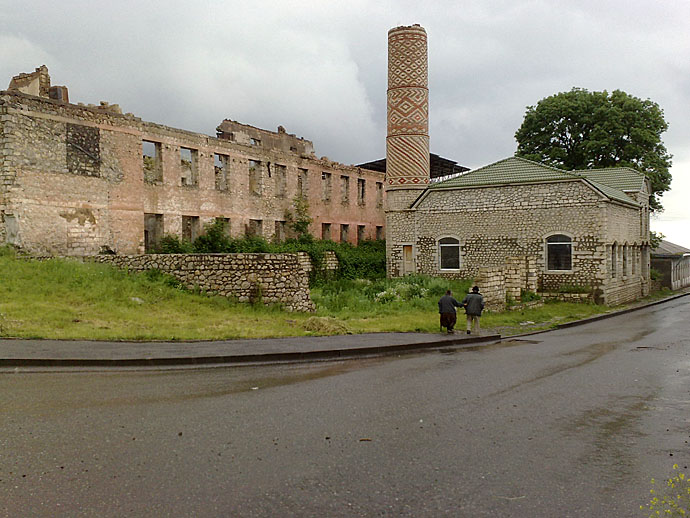
The last time I visited Nagorno Karabakh was in 2006. Well, the intention had not been to visit Karabakh itself, but rather the strategic town of Lachin situated within what the international community considers sovereign Azerbaijani territory under Armenian control. However, despite years of working on a long-term photographic project in the town, I was instead detained by the local National Security Service (NSS) and my travel plans altered in unexpected ways.
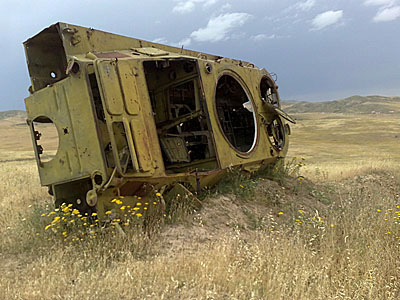 |
I was instructed to present myself immediately to the Foreign Ministry in Stepanakert, capital of the unrecognized and self-declared republic, and then return to Armenia.
Despite being entitled to visit Lachin as a holder of a 10-year Armenian residency visa, my detention had no legal basis and not least because I had already been welcomed by the regional deputy governor of part of the occupied territories as well as by the head of settlement. Indeed, I was actually detained upon leaving his office in the formerly Azeri and Kurdish-inhabited town that Armenians have since renamed Berdzor.
Besides, being married at the time to an Armenian citizen, my wife had relatives living in Lachin and we had constantly visited them. There had never been a problem.
Three years ago, however, that had all changed. With attempts to settle parts of the territory surrounding Karabakh faltering, the subject for two articles published by the Institute for War & Peace Reporting (IWPR) and EurasiaNet was sensitive enough to put the internal security services on edge. A senior official in Lachin later alleged that the order for my detention had come from Yerevan, but that still remains unclear.
Regardless, the excuse given in Stepanakert for my expulsion was laughable. "Nobody may enter Lachin," I was told much to the confusion of a local representative of a Diaspora foundation who accompanied me. As he scratched his head in confusion and disbelief I had to state the obvious. "So why did the acting governor not only welcome me, but also suggest villages that I should visit to interview residents for my articles, then?"
And, with the road from Armenia to Karabakh actually passing through the center of Lachin, there's no avoiding entering the town anyway. Instead, it was all quite clear. The authorities in Yerevan and Stepanakert were on edge about the exodus of settlers from Armenia inhabiting the regions surrounding the disputed territory and just wanted journalists to stay out. Fair enough, I thought, especially as I had enough material for my articles.
I did, however, promise myself not to go anywhere near Karabakh in the future. Unless I really had to, that is.
Well, three weeks ago that time came in the form of a fixing gig for the BBC and a photo assignment from The National. It would be interesting to see if I would be welcomed again in much the same way as before. Thankfully, I have to say, the situation was less tense and the authorities more inviting and accommodating this time round. Indeed, long gone were the days when journalists required written permission to travel anywhere outside the capital.
Access without permission was unfettered with the obvious exception of Aghdam, a once bustling market town inhabited by Azeris razed to the ground after it was taken by ethnic Armenian forces during the war of the early 1990s and still somewhat of an embarrassment when photographs of the ruins turn up in foreign publications, as well as the frontline itself. Still, the main purpose of the visit was to assess the mood in Karabakh in light of renewed efforts to resolve the conflict over the territory with Azerbaijan.
Surprisingly, Stepanakert was bustling with lots of construction everywhere. A new building for the Karabakh National Assembly took pride of place in Republic Square and luxury hotels were springing up elsewhere. Moreover, and despite concerns recently expressed by the unrecognized republic about a possible deal being hammered out by the presidents of Armenia and Azerbaijan, there seemed to be no feeling of imminent danger. Nevertheless, questions still need to be asked about where most of the money is coming from and whether the 148,000 population is accurate.
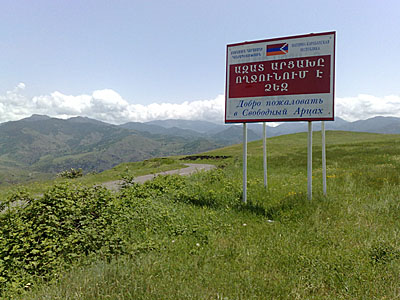 |
Yet, despite all the trappings of statehood, Karabakh still effectively remains an outpost of Armenia. Police, buses and civilian vehicles all have Armenian and not Karabakh number plates while the Armenian dram remains the local currency. Unrecognized by any other country in the world including Armenia, Karabakh residents travel abroad on Armenian passports and there is no official border between the two. Only a single sign welcoming visitors to "Independent Artsakh" stands by the roadside upon leaving Armenia.
Nevertheless, while Stepanakert might be bustling and calm, the frontline is not. Despite an agreement to withdraw snipers from the ceasefire line, Azerbaijan reportedly changed its mind after the much-publicized Moscow Declaration. As a result, tensions remain high with the time taken to target and fire at soldiers and civilians alike put at 6 seconds upon sighting. With the stand-off position between Karabakh and Azerbaijan forces so tense and as close as 20-40 meters in some locations, it is no wonder that clashes and skirmishes break out from time to time.
Even so, despite the risk of such clashes spiraling out of control, none of those officials or civilians interviewed in seemed anywhere close to being ready to embrace any form of a compromise peace deal. Moreover, what was concerning was that if once the territories around Karabakh had been described as a temporary security buffer zone they were now being referred to as "liberated." In the here and now, this means from the families that once lived in them.
Depressingly, otherwise moderate voices were of the same opinion even if there can never be any peace without their return. Basically, while the so-called Madrid Principles appear to be the basis for efforts to finally resolve the conflict 15 years after the 1994 ceasefire, the mood in Stepanakert was ostensibly conciliatory only in tone and not in substance. Removed from the negotiating process since former Karabakh president Robert Kocharian took the presidency in Armenia, Stepanakert seeks a new role even if it had never been a full or equal side in the talks in the past.
Others, however, are somewhat cautious about such a move given that Armenia's first president was forced to resign from office while considering a similar compromise deal by key figures from Karabakh and other officials. "If Karabakh is allowed the right to determine its own future, could territory be returned?" I asked Giorgi Petrossian, Karabakh's Foreign Minister. "Let us take part in the negotiations and then you'll find out," he responded. It is doubtful that anyone would risk such a move without a clear position being stated first.
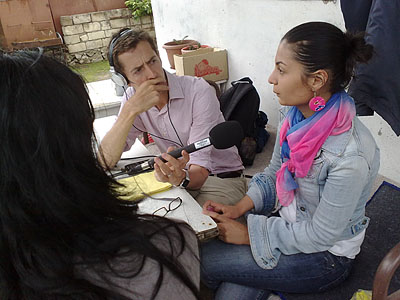 |
Lusine Musayelyan, a young 20-year-old journalist in Stepanakert who knows a mutual friend in Baku, perhaps represents the position of most Karabakh Armenians. "Why should we give up anything?" she asked somewhat rhetorically in between interviews held with the BBC and The National. "Because maybe there will be a new war in 5 or 10 years," I responded. Her eyes dulled. "Yes. Maybe," she said solemnly, resigned to the possibility that fresh conflict is not as unlikely as some local analysts suggest.
Her father was killed during the war so I wasn't going to continue the conversation in such circumstances any longer, although I did wonder if there wasn't a similarly bouncy and attractive 20-year-old girl in Azerbaijan also mourning the loss of one of her parents. Besides, Lusine is not what can be considered a die-hard nationalist and there was at least some sign of hope - or kind of. Sitting with us was a senior official from Karabakh's Ministry of Foreign Affairs, and when Lusine and I spoke about our mutual friend in Baku she lost her patience and reacted.
"If you like Azeris so much why don't you go and marry one!" she exclaimed. Despite believing that people are people wherever you are, I nevertheless decided not to respond.
Instead, undaunted, we continued to talk about a new breed of young Azeris who have become more active in their society in recent years. Although small in number, they appear to offer much in terms of offering hope for the future even despite the war. "Yes," the Karabakh official suddenly added much to my surprise. "I have some good Azeri friends too. The family of one even helped save Armenians when the troubles began. They risked everything to help their Armenian neighbours."
But it is this first knee-jerk reaction that remains the default in a region described by friend, journalist and and Black Garden: Armenia and Azerbaijan through Peace and War author Thomas de Waal as resembling a "geopolitical suicide-pact." In an article for openDemocracy he described the situation thus. "This kind of zero-sum thinking is most acute [...] between Armenians and Azerbaijanis, many of whom seem content to see their respective country suffer so long as the other side in the Nagorno-Karabakh conflict is feeling pain too," Tom wrote.
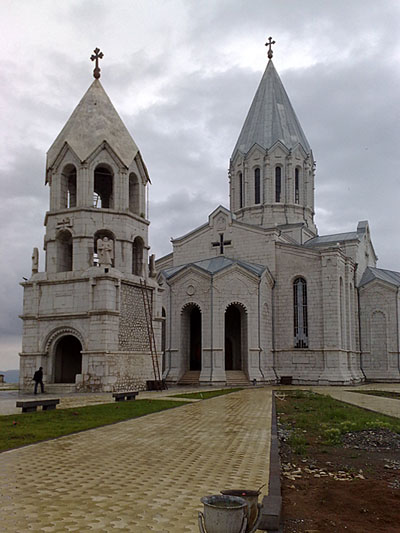 |
Meanwhile, Armenians and Azeris live and work together side by side in Russia, as well as Georgia and elsewhere, while being at each other's throats in their own countries. Aside from religion, sharing more similarities than differences, the reason for that is simple. The Karabakh conflict continues to be exploited by nationalists in both countries to justify the increasingly authoritarian nature of their respective regimes. At the same time, Karabakh is used by all political forces to maintain or come to power.
Ethnicity takes precedence over citizenship while Armenians and Azeris look more to the past than to the future. History is subjectively selective and each considers that it was only they that suffered. Instead, the repercussions from the tit-for-tat expulsion of each from both republics continue, with Yerevan and Baku now virtually mono-ethnic and suffering from the lack of charm and energy that cosmopolitan cities generally possess. A curse ethno-nationalism in the South Caucasus might be, but visit Tbilisi to see what cultural diversity can also offer.
However, even the idea of eventually restoring the once splendid Karabakh town of Shusha to its former glory is unlikely in the present environment. A major cultural center mainly inhabited by Azeris at the time of the 1989 census, Armenians say they can never live with Azeris again. The feeling might well be mutual. A notable tourist destination in the Soviet years, now the town is scarred and battered after much of it was destroyed by Armenians after its capture in 1992. Efforts to rejuvinate the town have been half-hearted at best with much of it remaining in ruins.
On the other side of the ceasefire line, Baku's almost constant rhetoric of war doesn't help either, but that's no surprise, I suppose. Even Georgia's Saakashvili did much the same when, after boasting he would give South Ossetians and Abkhaz separatists reason enough to return to the fold, he then ordered the bombardment of Tskhinvali, capital of the former. So much for patience or recognizing the rights of what you earlier claimed were your own citizens, then.
Armenians in Karabakh do not want to be part of Azerbaijan and are not being given any reason to change that position. Moreover, entrenched and hard-line positions on both sides are self-perpetuating and counter-productive even if the OSCE Minsk group is believed to be facilitating negotiations over a compromise peace deal which would allow Karabakh to determine its own fate in a referendum to be held anywhere between 5-10 or even 15 years after a final agreement. In return Armenians would return at least six of the seven Azeri regions under their control.
But nationalist ideologies which have no place in the modern world continue to be perpetuated by the near constant dissemination of propaganda from both sides as well as the lack of communication between Armenians and Azeris as individuals. There are exceptions, of course, but civil society appears to have failed to engage in genuine peace-building and conflict-resolution initiatives while the local mass media prefers to either promote negative stereotypes of the "enemy" or practices self-censorship.
The prospects for peace look slim unless genuinely encouraged and guaranteed by the international community.
Unfortunately, as it stands, while nationalists in Armenia refuse to consider that Azeri IDPs have the right under international law to return to their homes in the territories surrounding the territory or to towns such as Shusha in Karabakh proper, their counterparts in Azerbaijan at the same time fail to even pause for thought about the grievances and aspirations of Karabakh's Armenians. Indeed, the prevailing mood on both sides is perhaps best described by David Pugh's Seven Rules of Nationalism.
1. If an area was ours for 500 years and yours for 50 years, it should belong to us - you are merely occupiers.
2. If an area was yours for 500 years and ours for 50 years, it should belong to us - borders must not be changed.
3. If an area belonged to us 500 years ago but never since then, it should belong to us - it is the Cradle of our Nation.
4. If a majority of our people live there, it must belong to us - they must enjoy the right of self-determination.
5. If a minority of our people live there, it must belong to us - they must be protected against your oppression.
6. All the above rules apply to us but not to you.
7. Our dream of greatness is Historical Necessity, yours is Fascism. link
On a brighter note, and despite the seemingly intractable nature of the Nagorno Karabakh conflict, the BBC's Tom Esslemont does at least manage to inject a little humour into proceedings in an excellent radio report while one of the first articles written by Daniel Bardsley for The National on mine and UXO clearance in Karabakh by the HALO Trust was published this weekend. There will be more to come accompanied by my photographs, but because they were commissioned those in this post are once again from my trusty Nokia N82.
Tom also has a text and video reports from Karabakh here and here.
 |
Meanwhile, on a more personal note, some of us will be hoping for peace, but continue to fear the worst. What could be a colourful culturally rich and enticing region will instead remain ripped apart by ethnic divides and geopolitical intrigues which continue to threaten its long term stability, prosperity and full potential as a link between East and West. Instead of compromise in the interest of peace and reconcilliation, an arms race looks set to continue until something finally snaps or one side gives in. Those on both sides should probably take a look at long hard look at Conciliation Resources recent report, The Karabakh Trap. It's available in English, Armenian, Azeri and Russian.
The conflict between Armenians and Azeris over Nagorny Karabakh (NK) continues to pose serious dangers to the future of the South Caucasus but is still low on the international agenda. There is a misconception that it is 'frozen', yet the conflict is gradually thawing and there is a danger that fighting could resume.
Although a peace agreement is in everyone's long-term interests, the parties involved are driven by short-term motives and are more comfortable with the status quo. They are caught in a 'Karabakh trap', where societies have been encouraged to have unrealistic expectations of what can be achieved and where compromise is fraught with risk. link
Photos from top to bottom: Mosque, Shusha, Nagorno Karabakh -- Askeran, Nagorno Karabakh -- Sign welcoming visitors to Nagorno Karabakh -- Tom Esslemont interviewing Lusine Musayelyan for the BBC -- Cathedral, Shusha, Nagorno Karabakh -- Lachin © Onnik Krikorian / Oneworld Multimedia 2009

Great one, Onnik. Unfortunately, the clouds are gathering. Unless the international community starts taking this seriously, this could go towards war.